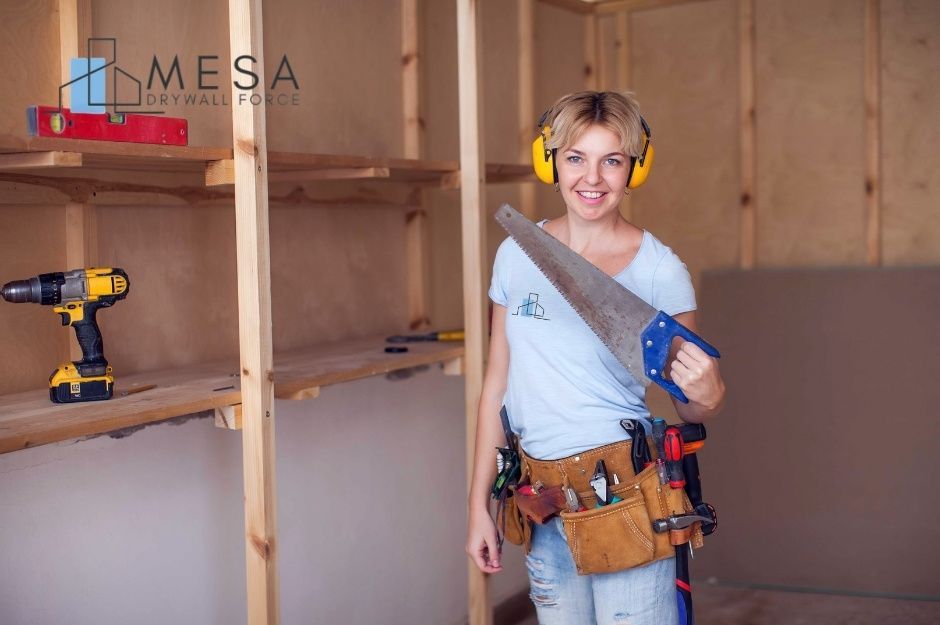Drywall Repair Glendale
High-quality Sheetrock Repair Company in Glendale, Arizona

Drywall problems can strike at any moment, leaving unsightly holes, cracks, or water damage in your Glendale home. From small patches to complete installations, Mesa Drywall Force provides professional drywall services in Glendale, AZ, offering comprehensive solutions for all your wall and ceiling needs. Local drywall contractors typically charge between $40-$100 per hour with most basic repairs ranging from $125-$400 depending on the size and complexity of the damage.

Mesa Drywall Force (CP)

With Glendale's population of 248,325 residents spread across 65.1 square miles, homeowners throughout the city—from properties near State Farm Stadium to neighborhoods around Arrowhead Towne Center—rely on skilled drywall professionals to maintain their homes. Whether you're dealing with popcorn ceiling repairs, corner bead damage, or joint separations, Glendale's qualified drywall specialists have the expertise to restore your walls to pristine condition. Their services include patching holes, fixing ceiling cracks, removing or repairing popcorn textures, and addressing water damage through proven repair techniques.
Glendale's hot desert climate (Köppen: BWh) with summer temperatures reaching up to 122°F and winter lows around 35°F creates unique challenges for drywall installations. The extreme temperature fluctuations and low humidity levels (averaging just 36.6% annually) can cause drywall materials to expand and contract significantly, making proper installation techniques and climate-appropriate materials essential for long-lasting repairs.
Professional drywall repair and installation ensures your home maintains its structural integrity and aesthetic appeal. Many Glendale contractors offer free estimates, allowing you to understand the scope and cost of your project before work begins.
Expert Drywall Repair in Glendale, AZ
Professional drywall repair services in Glendale address common wall and ceiling damage with precision and expertise. Local specialists use advanced techniques and premium materials to restore your surfaces to their original condition.
Patch a Hole
Small holes from picture hooks or anchors require spackling compound and a putty knife for a smooth finish. For medium-sized holes up to 6 inches, you'll need a drywall patch kit with adhesive mesh and joint compound.
Large holes demand a more extensive repair process. A professional will cut the damaged section into a clean rectangle and install a new drywall piece, securing it to the wall studs.
In Glendale's desert environment, contractors must account for the city's average annual precipitation of just 7.22 inches and extreme dryness, which can affect how quickly joint compounds cure and may require adjusted application techniques for optimal results.
The repair process includes multiple layers of joint compound, sanding between coats, and texture matching to blend seamlessly with surrounding walls.
Repair a Crack in Ceiling
Ceiling cracks often stem from settling foundations or temperature fluctuations. Given Glendale's extreme temperature variations—with daily maximums averaging 106.5°F in July and minimums of 45.3°F in December—foundation settling and thermal expansion are particularly common causes of ceiling cracks in local homes. Quick identification prevents further damage and costly repairs.
Professionals assess the crack's cause before beginning repairs. They clean the area, apply fiberglass mesh tape, and cover it with joint compound.
The repair requires 2-3 coats of compound, with careful sanding between applications. Proper texture matching ensures the repair blends naturally with the rest of your ceiling.
Popcorn Ceiling Repair
Popcorn texture repairs require careful preparation to avoid damaging surrounding areas. Professionals mask off the work zone and protect your floors and furniture.
During Glendale's monsoon season (July-August), when the city receives most of its annual 7.22 inches of precipitation, water damage to popcorn ceilings becomes more common, requiring specialized drying and restoration techniques. For water damage, the affected area must dry completely before repairs begin. The contractor will scrape away damaged texture, repair any underlying issues, and apply new matching popcorn material.
Small patches need careful blending techniques to match the existing texture pattern. Many contractors use specialized spray equipment to achieve consistent results.
Comprehensive Ceiling and Joint Solutions
Professional drywall repair services address ceiling damage, deteriorating corner beads, compromised joints, and water-related issues to restore the structural integrity and appearance of your walls and ceilings.
Ceiling Repair
Ceiling repairs encompass fixing cracks, holes, and damaged textures. The repair process starts with cleaning and prepping the affected area.
For popcorn ceiling repairs, contractors carefully match the existing texture pattern using specialized spray equipment. Small cracks require joint compound application and sanding for a seamless finish.
Large holes need proper support backing, and new drywall installation before texturing. Professional contractors charge $40-100 per hour for ceiling repairs, with most basic repairs ranging from $125-200.
Corner Bead Restoration
Corner bead damage often occurs from impact or improper installation. In Glendale's dry climate, with relative humidity averaging just 19.4% during peak summer months, metal corner beads can be particularly susceptible to expansion and contraction issues, making proper installation and material selection crucial for longevity. Metal or vinyl corner beads protect vulnerable drywall corners and create clean, straight edges.
The restoration process involves removing damaged sections, installing new corner bead, and applying joint compound in multiple layers. Each layer must dry completely before sanding.
Proper corner bead installation prevents future damage and maintains crisp wall angles. Your contractor will ensure proper alignment and secure attachment to the framing.
Joint Repair
Joint problems appear as cracks or tape separation along seams between drywall panels. Professional repair begins with removing loose tape and cleaning the joint area.
Fresh joint compound and tape application creates a strong bond. Multiple thin coats work better than one thick layer.
Glendale's intense UV exposure, averaging 7.0 on the UV Index annually with peak summer readings of 11.0, can cause paint and joint compounds near windows to degrade faster, requiring more frequent maintenance in sun-exposed areas. Your contractor will feather the edges of each coat to blend with surrounding surfaces. Proper sanding between coats ensures a smooth finish that matches existing wall texture.
Water Damage Remediation
Water-damaged drywall requires immediate attention to prevent mold growth and structural issues. First, identify and fix the water source to prevent recurring damage.
Despite Glendale's desert location nine miles northwest of Phoenix, water damage can occur from monsoon flooding, plumbing leaks, or issues with the historic Arizona Canal system that originally brought water to transform this desert area in 1885. Remove all wet material beyond the visible damage area. New moisture-resistant drywall installation may be recommended for areas prone to water exposure.
Professional contractors use moisture meters to ensure complete drying before repairs begin. The remediation process includes antimicrobial treatments when necessary to prevent future issues.
Matching existing textures and paint ensures seamless integration with undamaged areas.
Professional Drywall Installation and Finishing
Professional drywall work requires precise measurements, proper techniques, and attention to detail for smooth, durable walls that meet building codes and aesthetic standards.
Drywall Installation
Start with measuring and cutting drywall sheets to fit your wall dimensions precisely. Secure the sheets to wall studs or ceiling joists using drywall screws placed every 12 inches along edges and 16 inches in the field.
In Glendale's climate, where summer temperatures can reach record highs of 122°F and winter lows can drop to 16°F, contractors must account for significant thermal expansion when spacing screws and planning seam placement to prevent future cracking. For optimal results, install larger sheets horizontally on walls to minimize seams. Leave a 1/4-inch gap at the floor to prevent moisture damage.
Use drywall clips or blocking behind unsupported seams to prevent sagging and cracking. Cut precise holes for electrical boxes and other fixtures using a drywall saw or rotary tool.
Drywall Finishing
Apply joint compound in three thin layers over seams and screw heads. Use paper tape for flat seams and mesh tape for corners to prevent future cracking.
Let each layer dry completely and sand lightly between coats. Glendale's low humidity levels (averaging 36.6% annually) can actually work in favor of drywall finishing, as joint compounds typically cure faster than in more humid climates, potentially reducing project timelines. The first coat fills gaps, the second smooths transitions, and the final coat blends everything together.
Match existing wall textures using specialized tools and techniques. Choose from common patterns like orange peel, knockdown, or smooth finish.
Prime the finished surface before painting to ensure even absorption and a professional appearance. This step reveals any imperfections that need touching up.
